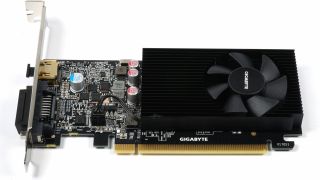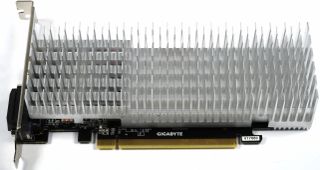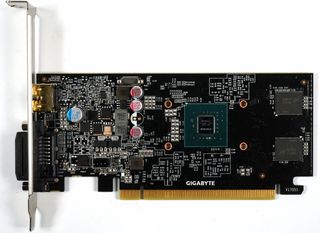Nvidia GeForce GT 1030 2GB Review
Why you can trust Tom's Hardware
Meet Gigabyte's Low-Profile GeForce GT 1030 Cards
Gigabyte GeForce GT 1030 Low Profile 2G
The length of Gigabyte's GeForce GT 1030 Low Profile 2G, from the edge of its slot bracket to the end of the cooler, is just 15.2cm. Its height, from the bottom of the PCIe slot to the cooler's top, is 7cm. A depth of 1.5cm is less than the width of a slot bracket, so you're firmly in single-slot territory here.

This card is also incredibly light at just 135g. Its slot bracket can be removed easily by unfastening a screw in order to switch it out for the bundled low-profile bracket.


There’s no backplate; it's simply not needed. The same goes for any other form of eye candy. Gigabyte's goal is to keep things simple, enabling the lowest price possible.

Given a 30W TDP, there's also no need for an auxiliary power connector. This card gets everything it needs from the motherboard's PCIe slot.

Air flows horizontally across the small heat sink. Most of it is pushed in the direction of the PC case’s side wall.
A dual-link DVI-D connector (without an analog signal) and an HDMI 2.0b port are found on the slot bracket.


Gigabyte GeForce GT 1030 Silent Low Profile 2G
The GT 1030 Silent Low Profile 2G is, as its name reveals, also a low-profile card. It's height matches the actively-cooled model. But it's longer: the outer edge of the slot bracket to the end of the cooler measures 17.5cm. The passive version of Gigabyte’s GT 1030 isn't quite as slim, and it's also significantly heavier at 336g.

A depth of 3.5cm is attributable to the heat sink's many fins. This makes the card exactly two expansion slots wide. Again, the full-length slot bracket can be switched out for a bundled low-profile one.


The two cards’ PCBs are identical with one exception: the silent model lacks a fan connector. It has the space for it, but Gigabyte omits this component to save money.

Naturally, a passive design is dominated by cooling fins. There are spaces between the fins both horizontally and vertically, so thermal performance should be comparable regardless of the orientation in your case. Wherever air is coming from, the heat sink behaves similarly.

Although it'd be nice to have DisplayPort connectivity, the same DVI-D and HDMI 2.0b connectors have to suffice.


Support for 4K output at 60Hz makes both of these cards great choices in HTPCs.
Board Layout
The two identical PCBs don’t really have any unique features, but we'll still take a closer look at them.

At first, Gigabyte designed its GT 1030s with just one power phase in mind. However, the company switched to two for thermal reasons; a one-phase solution would have resulted in extreme hot-spots.
The two phases are controlled by a small uPI Semiconductor uP1666 buck controller. Alpha & Omega Semiconductor supplies the low-side's AON6414A and high-side's AON6508 MOSFETs.


Foxonn's Magic chokes do their job without fanfare. Our instrumentation tells us they're completely inaudible at the current levels running through them on these graphics cards.
The graphics memory is sourced from Micron. We find two 1GB GDDR5 modules operating at 6 Gb/s. Attached to a 64-bit aggregate bus, they achieve a peak bandwidth of 48 GB/s.


The memory’s PWM controller is hidden well around back. uPI Semiconductor's uP1542 is a simple single-channel buck controller responsible for the GDDR5's one phase. Both the high- and low-side are taken care of by a single QM3203S dual N-channel fast-switching MOSFET.


The Two Coolers
Both coolers are made from extruded aluminum. That's where their similarities end, though. The active model's heat sink is black, 9cm long, and 1cm thick. It doesn’t cover the voltage regulation circuitry. Then again, it couldn’t really be any longer without hitting capacitors and coils.
The 5cm fan is recessed into the cooler. It has seven blades and is designed to maximize airflow.

Meanwhile, the passive heat sink is 17cm long and 3.2cm thick. There's even a part specifically designed to help cool the VRM.

Its surface has not been treated in any way. The thick cooling fins have many small grooves, which significantly increase their surface area.
MORE: Best Graphics Cards
MORE: Desktop GPU Performance Hierarchy Table
MORE: All Graphics Content
Current page: Meet Gigabyte's Low-Profile GeForce GT 1030 Cards
Prev Page Meet GeForce GT 1030 2GB Next Page How We Tested GeForce GT 1030Stay on the Cutting Edge
Join the experts who read Tom's Hardware for the inside track on enthusiast PC tech news — and have for over 25 years. We'll send breaking news and in-depth reviews of CPUs, GPUs, AI, maker hardware and more straight to your inbox.
-
turkey3_scratch This is a fantastic chip! Seeing as it performs nearly on-par with the 750Ti, it has approximately double the performance/power ratio. It is also perfect for a noiseless PC, the passively cooled one is.Reply -
takeshi7 Does this card work with 4K Netflix? From what I've read Nvidia requires 3GB VRAM for it which seems stupid and arbitrary. 2GB is enough to buffer several seconds of 4K movie frames.Reply -
King_V Definitely interesting. Going through the initial tests, I actually started wondering why the RX550 was lower in the hierarchy charts than the 750Ti.Reply
Then, when they switched positions in some other tests, it became more clear. And, I concluded that even putting certain cards in tiers relative to each other is not that easy.
I was very glad to see this test, though, as I'd previously considered getting the GT1030. My need for it is no longer there.
Overall, I think the 750Ti, RX 550, and RX 460 are closer to each other than I anticipated. It does seem the 1030 is behind them all, but not too far behind.
Thanks for this review. I can't wait to see where it ultimately falls in the hierarchy chart(which, oddly, is missing the RX 560 but I suspect that is in the same tier as the RX 460) -
hendriksnyder Will this work with a core I7 7700k? And would it be able to run games like FO4 and TitanFall 2 on ultra settings?Reply -
takeshi7 Reply19934708 said:TAKESHI7
yes it's enough, IDK where you heard that you need 3gb or VRAM.
Multiple sources say you need 3GB VRAM
http://nvidia.custhelp.com/app/answers/detail/a_id/4457/~/preview-of-4k-uhd-netflix-content-on-nvidia-gpus
http://www.pcworld.com/article/3193566/components-graphics/nvidia-quietly-opens-4k-netflix-streaming-on-geforce-gtx-10-series-graphics-cards.html
It's pretty stupid because that means you have to spend twice as much to get a 1050 Ti minimum.
-
zcat Can't wait to swap out my miniITX's old 750Ti with a true successor that's twice as powerful at the same bus-powered max of 60W.Reply -
mikegrok I am going to be installing a bunch of these into a dental office as soon as stocks get better. Dental offices have 2 monitors per computer (usually using the gti 720). One for work, and one to show Netflix, and distract the patients. The computers have CPUs that don't accelerate h265, and the 1000 series nvidia GPUs accelerate the current video codecs.Reply